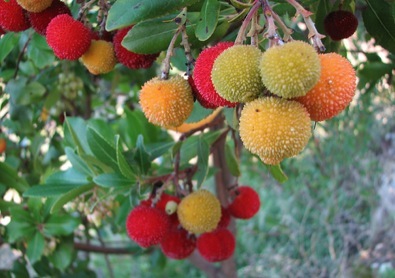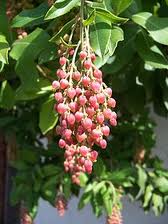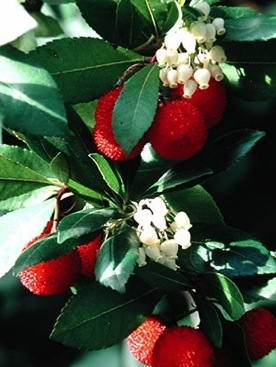Strawberry Tree, Koumaria, Koumara, Pacific Madrone, Madrona
Any plant called “strawberry” other than a strawberry is doomed. Strawberries pack a lot of particular flavor and sweetness. Most other things called strawberry do not.
The Strawberry Guava doesn’t. The Indian Strawberry doesn’t. The Strawberry Tree doesn’t, and its sibling, the other Strawberry Tree doesn’t either. These four fruits have their own flavor and appeal that gets lost in the pronouncement that they are not as good as the strawberry. And that is accurate. None of them are as extroverted as the strawberry, but they are not strawberries. You have to get past that.
Like the rest, the Strawberry Tree, Arbutus unedo, is doomed in English, as Arbutus mensiesii related Strawberry Tree. In Greek the former is called Koumaria (koo-mar-ree-AH) which is also the name of a town and a heck of a lot of hotels. The perfectly round fruit of the tree, a favorite of children, is called Koumara (no i.) Goats love the leaves, as do deer. But best of all, Koumara are Koumara, and they’re good unto themselves. A. unedo takes a year to put on fruit and ripen so it is loosing fruit just about the time it is flowering again. Called madronos in Spanish, Corbezzolo in Italian, and sometimes Bearberry in English as well as the Apple of Cain and Cain Apple. The fruit smells like anise but doesn’t taste like that, more along the lines of a woody strawberry, or a cross between guava and nectarine However, unripe it can cause nausea, on the other hand it can ferment on the branch and cause mild intoxication. From a health point of view it does have Vitamin C. The bark has tannins for working leather or as a dye.
The second Strawberry Tree is A. mensiesii, also called the Pacific Madrone, or Madrona. Native to northwestern North America, it can be found cultivate in non-hot areas of the country. Every September I get several emails from folks wondering if the fruit is edible because there are Internet reports that it is toxic. It is not. Most folks think it is some kind of dogwood, but it is not. It’s berries are edible but astringent. The Indians made them into cider or just chewed them. A more distant relative, the Mayflower, or the Trailing Arbutus, is also an edible. See a separate entry for that.
Arbutus (arb-YEW-tus) means struggle. Unedo (YOU-nee-doe) means “I eat only one” from the Latin unum edo. That can be read two ways: It is so good I only eat one, or it is rather it is uninteresting thus I only eat one. We got that in 50 AD from Pliny the Elder (23 AD – August 25, 79), and we don’t know which he meant. Mensiesii honors the discoverer, Archibald Menzies (1754-1842), a Scottish physician and naturalist.
The Arbutuses are in the heath family. Oddly, A. unedo also grows in Ireland where in Gaelic it is called Caithne. Some think it is a pre-ice age hold over. In might have been introduced by the Beaker People around 4,000 BC according to pollen found in bogs. Incidentally, there is an old Irish folk song “My Love’s An Arbrutus.” The words are by the recipes below.
Several species in the genus Arbutus are ornamentals. A. andrachne (the Eastern Strawberry Tree) has small edible berries and cinnamon-colored bark. It is often confused with a hybrid, A. andrachnoides , which has small, hard edible fruit and perfectly smooth bark ranging from deep red to bright yellow. Fruit of the Arbutus marina, however, is edible.
When I travel back to the “old country” the two things I notice about plants is how many familiar ones there are. Weeds are cosmopolitan. Then there are the natives. Edible figs grow wild in southern Greece, as does the deadly Oleander but also thyme, basil, savory, rosemary, oregano and marjoram. In Crete the fruit of the Koumaria is made into a local distillation called Koumaro. Having visited Crete many times I think the Cretans can make tail pipe-kicking radiator fluid out of nearly anything.
Green Deane’s “Itemized” Plant Profile
IDENTIFICATION: The Strawberry Tree, grows to 15 to 35 feet tall, evergreen leaves are dark green, glossy, two to four inches long, up to an inch wide with a serrated edge.Young leaves have red veins. Blossoms are white (occasionally pale pink), bell-shaped, like a blueberry blossom, honey scented. Fruit is a red berry to 3/4 of an inch through, rough surface, maturing 12 months. In southern US the tree is about 10 feet tall. Older specimens have gnarled trunk and branches. Many cultivars including “Compacta, Rubra, Elifn King, Quercifolia, Croomei, Melita, and Werner.
TIME OF YEAR: Fruit usually ripens in later summer or fall. Mealy, amber flesh. Tree blooms autumn into winter
ENVIRONMENT: Native to rocky well-drained soil, full sun except in deserts where it needs partial shade
METHOD OF PREPARATION: Out of hand, jams, jellies, pies, candied fruit, wine and spirits. See recipes below.
Strawberry Tree Jam
Two pounds of fruit
A pound of sugar
Four ounces orange liquor
Slowly boil the fruit with a little water until soft. Press through a mill then reheat with the sugar and liqueur. Simmer until a drop mounds on a chilled dish.
Option: Add some cinnamon, cloves, nutmeg and vanilla for added flavor.
Strawberry Tree Jelly
Arbutus berries, sugar, water.
Rinse fruits. Put them in a preserving pan and cover with cold water almost completely. . Bring on the heat and cook for about fifteen minutes over low heat. Pass the fruit through a cheesecloth, pressing well to catch any juice.
Weigh it. Mix the juice with its weight of sugar. Simmer over low heat, skimming rather soft at times. Cooking is complete when the juice forms small beads. Cool before placing in jars.
My Love’s An Arbutus
My love’s an arbutus
By the borders of Lene,
So slender and shapely
In her girdle of green.
And I measure the pleasure
Of her eye’s sapphire sheen
By the blue skies that sparkle
Through the soft branching screen.
But though ruddy the berry
And snowy the flower
That brighten together
The arbutus bower,
Perfuming and blooming
Through sunshine and shower,
Give me her bright lips
And her laugh’s pearly dower.
Alas, fruit and blossom
Shall lie dead on the lea,
And Time’s jealous fingers
Dim your young charms, Machree.
But unranging, unchanging,
You’ll still cling to me,
Like the evergreen leaf
To the arbutus tree.




